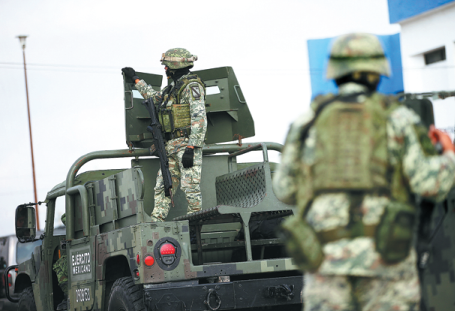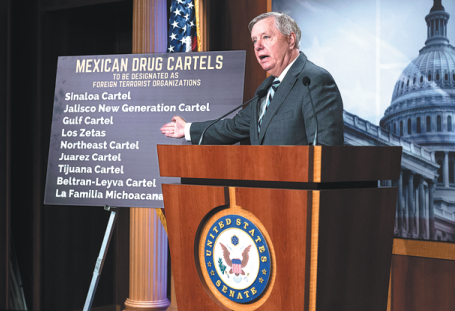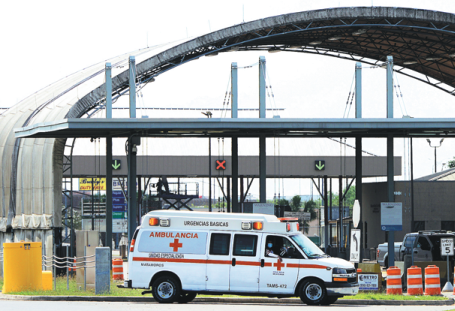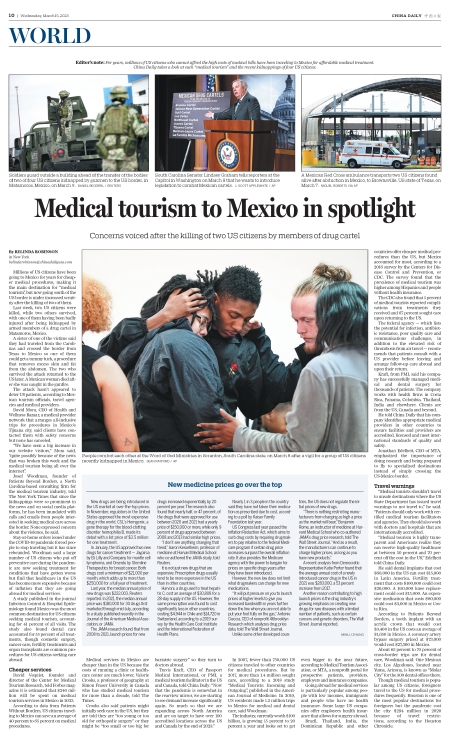
Soldiers guard outside a building ahead of the transfer of the bodies of two of four US citizens kidnapped by gunmen to the US border, in Matamoros, Mexico, on March 9.

South Carolina Senator Lindsey Graham tells reporters at the Capitol in Washington on March 8 that he wants to introduce legislation to combat Mexican cartels.

A Mexican Red Cross ambulance transports two US citizens found alive after abduction in Mexico, to Brownsville, US state of Texas, on March 7.

People comfort each other at the Word of God Ministries in Scranton, South Carolina state, on March 8 after a vigil for a group of US citizens recently kidnapped in Mexico.
Editor's note: For years, millions of US citizens who cannot afford the high costs of medical bills have been traveling to Mexico for affordable medical treatment. China Daily takes a look at such "medical tourism" and the recent kidnappings of four US citizens.
Millions of US citizens have been going to Mexico for years for cheaper medical procedures, making it the main destination for "medical tourism", but now going south of the US border is under increased scrutiny after the killing of two of them.
Last week, two US citizens were killed, while two others survived, with one of them having been badly injured after being kidnapped by armed members of a drug cartel in Matamoros, Mexico.
A sister of one of the victims said they had traveled from the Carolinas and crossed the border from Texas to Mexico so one of them could get a tummy tuck, a procedure that removes excess skin and fat from the abdomen. The two who survived the attack returned to the US later. A Mexican woman died after she was caught in the gunfire.
The attack hasn't appeared to deter US patients, according to Mexican tourism officials, travel agencies and medical providers.
David Mora, CEO of Health and Wellness Bazaar, a medical provider network that arranges all-inclusive trips for procedures in Mexico's Tijuana city, said clients have contacted them with safety concerns but none has canceled.
"We have seen a big increase in our website visitors," Mora said, "quite possibly because of the news that was broken this week and the medical tourism being all over the internet".
Josef Woodman, founder of Patients Beyond Borders, a North Carolina-based consulting firm for the medical tourism industry, told The New York Times that since the kidnappings were so prominent in the news and on social media platforms, he has been inundated with calls and emails from people interested in seeking medical care across the border. None expressed concern about the violence, he said.
Stay-at-home orders issued under the COVID-19 pandemic forced people to stop traveling but it has since rebounded. Woodman said a large number of US citizens who put off preventive care during the pandemic are now seeking treatment for conditions that have gotten worse but find that healthcare in the US has become more expensive because of inflation that they are going abroad for medical services.
A study published in the journal Infection Control & Hospital Epidemiology found Mexico was the most common destination for US citizens seeking medical tourism, accounting for 41 percent of all visits. The study also found dental care accounted for 55 percent of all treatments, though cosmetic surgery, cancer care, fertility treatments and organ transplants are common procedures for US citizens seeking care abroad.
Cheaper services
David Vequist, founder and director of the Center for Medical Tourism Research, told Forbes magazine it is estimated that $240 million will be spent on medical tourism services in Mexico in 2023.
According to data from Patients Without Borders, US citizens traveling to Mexico can save an average of 40 percent to 65 percent on medical procedures.
Medical services in Mexico are cheaper than in the US because the costs of running a clinic or healthcare center are much lower, Valorie Crooks, a professor of geography at Simon Fraser University in Canada who has studied medical tourism for more than a decade, told The Times.
Crooks also said patients might initially seek care in the US, but they are told they are "too young or too old for orthopedic surgery" or they might be "too small or too big for bariatric surgery" so they turn to doctors abroad.
Travis Kraft, CEO of Passport Medical International, or PMI, a medical tourism facilitator in the US and Canada, told China Daily: "Now that the pandemic is somewhat in the rearview mirror, we are starting to see demand increase significantly again. So much so that we are expanding across North America and are on target to have over 100 accredited locations across the US and Canada by the end of 2023."
In 2007, fewer than 750,000 US citizens traveled to other countries for medical procedures. But by 2017, more than 1.4 million sought care, according to a 2018 study "Medical Tourists: Incoming and Outgoing", published in the American Journal of Medicine. In 2019, US residents made 1.2 million trips to Mexico for medical and dental care, said Woodman.
The industry, currently worth $100 billion, is growing 15 percent to 20 percent a year and looks set to get even bigger in the near future, according to Medical Tourism Association, or MTA, a nonprofit portal for prospective patients, providers, employers and insurance companies.
Going abroad for medical services is particularly popular among people with low incomes, immigrants and people who have no health insurance. Some large US companies offer employees health insurance that allows for surgery abroad.
Brazil, Thailand, India, the Dominican Republic and other countries offer cheaper medical procedures than the US, but Mexico accounted for most, according to a 2016 survey by the Centers for Disease Control and Prevention, or CDC. The survey found that the prevalence of medical tourism was higher among Hispanics and people without health insurance.
The CDC also found that 5 percent of medical tourists reported complications from treatments they received and 67 percent sought care upon returning to the US.
The federal agency — which lists the potential for infection, antibiotic resistance, poor quality care and communications challenges, in addition to the elevated risk of thrombosis from air travel — recommends that patients consult with a US provider before leaving and arrange follow-up care abroad and upon their return.
Kraft, from PMI, said his company has successfully managed medical and dental surgery for thousands of patients. The company works with health firms in Costa Rica, Panama, Colombia, Thailand, India and elsewhere. Clients are from the US, Canada and beyond.
He told China Daily that his company identifies appropriate medical providers in other countries to ensure facilities and providers are accredited, licensed and meet international standards of quality and safety.
Jonathan Edelheit, CEO of MTA, emphasized the importance of doing research and being prepared to fly to specialized destinations instead of simply crossing the US-Mexico border.
Travel warnings
"Medical tourists shouldn't travel to unsafe destinations where the US State Department has issued travel warnings to not travel to," he said. "Patients should only work with certified medical tourism facilitators and agencies. They should also work with doctors and hospitals that are internationally accredited.
"Medical tourism is highly transparent and Americans realize they can receive high-quality healthcare at between 50 percent and 70 percent off the cost in the US," Edelheit told China Daily.
He said dental implants that cost $60,000 in the US can cost $15,000 in Latin America. Fertility treatment that costs $100,000 could cost $20,000. A $50,000 knee replacement could cost $15,000. An expensive medication that costs $80,000 could cost $3,000 in Mexico or Costa Rica.
According to Patients Beyond Borders, a tooth implant with an acrylic crown that would cost $3,400 in the US costs an average of $1,650 in Mexico. A coronary artery bypass surgery priced at $73,000 would cost $27,300 in Mexico.
About 65 percent to 70 percent of cross-border trips are for dental care, Woodman said. One Mexican city, Los Algodones, located near Yuma, Arizona, is known as "Molar City" for the 300 dental offices there.
Though medical tourism is popular among US citizens, foreigners travel to the US for medical procedures frequently. Houston is one of the most popular destinations for foreigners but the pandemic cost the city $294 million in 2020 because of travel restrictions, according to the Houston Chronicle.
belindarobinson@chinadailyusa.com

